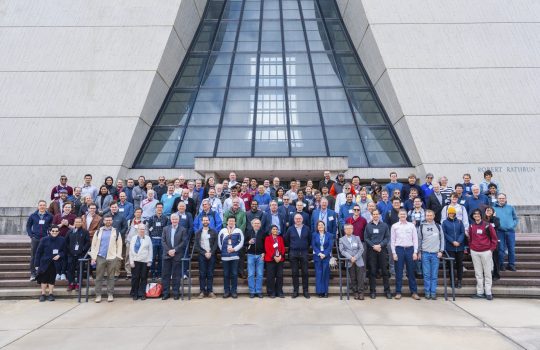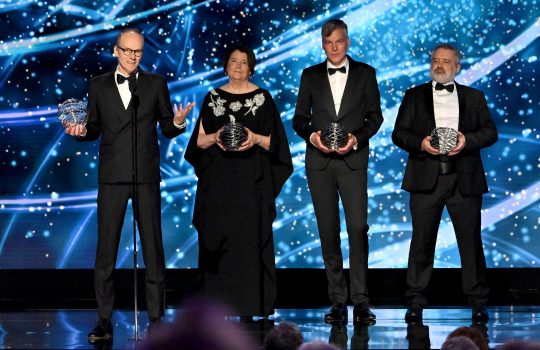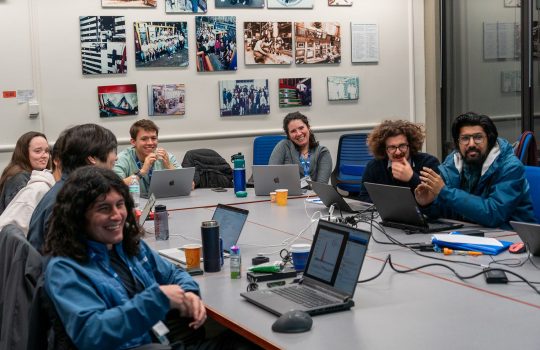Editor’s note:
The following US LHC news release was jointly issued by the U.S. Department of Energy’s Fermi National Accelerator Laboratory and Brookhaven National Laboratory. Fermilab serves as the U.S. hub for the nearly 1,000 scientists and engineers from U.S. universities and laboratories who participate in the Compact Muon Solenoid (CMS) experiment. Fermilab hosts the LHC Physics Center (LPC), a center for U.S. scientists who take part in the 3,000-member CMS collaboration. Fermilab houses a Remote Operations Center for the CMS experiment, allowing scientists to take shifts monitoring the CMS detector from the United States. Fermilab scientists, engineers and technicians made significant contributions to the design and construction of both the LHC and the CMS detector and are working on upgrades to both machines. About 120 Fermilab scientists now contribute to the operation of the CMS detector and to analysis of data from the CMS experiment. Fermilab is a Tier-1 computing center; it is one of 11 computing centers in the world that manages LHC data after initial processing. Fermilab provides about a quarter of the CMS experiment’s computing power. “Today’s announcement is the result of tireless work by an international collaboration of thousands,” said Fermilab Director Pier Oddone. “We’re proud of the many contributions that scientists, engineers and students from Fermilab have made to the LHC.”
Physicists on experiments at the Large Hadron Collider announced today that they have observed a new particle. Whether the particle has the properties of the predicted Higgs boson remains to be seen.
Hundreds of scientists and graduate students from American institutions have played important roles in the search for the Higgs at the LHC. More than 1,700 people from U.S. institutions–including 89 American universities and seven U.S. Department of Energy (DOE) national laboratories–helped design, build and operate the LHC accelerator and its four particle detectors. The United States, through DOE’s Office of Science and the National Science Foundation, provides support for research and detector operations at the LHC and also supplies computing for the ATLAS and CMS experiments.
The results announced today are labeled preliminary. They are based on data collected in 2011 and 2012, with the 2012 data still under analysis. A more complete picture of today’s observations will emerge later this year after the LHC provides the experiments with more data.
The new particle is in the mass region around 125-126 GeV. Publication of the analyses shown today is expected around the end of July.
“I congratulate the thousands of scientists around the globe for their outstanding work in searching for the Higgs boson,” said U.S. Secretary of Energy Steven Chu. “Today’s announcement on the latest results of this search shows the benefits of sustained investments in basic science by governments around the world. Scientists have been looking for the Higgs particle for more than two decades; these results help validate the Standard Model used by scientists to explain the nature of matter.”
The CMS and ATLAS experiments in December announced seeing tantalizing hints of a new particle in their hunt for the Higgs, the missing piece in the Standard Model of particle physics. Since resuming data-taking in March 2012, the CMS and ATLAS experiments have more than doubled their collected data. The statistical significance of the earlier hints has grown.
“What has been announced today could not have been accomplished without the cooperation of scientists and nations throughout the world in seeking an understanding of the fundamental laws of nature,” said Ed Seidel, NSF’s assistant director for the Mathematical and Physical Sciences. “If the particle announced today at CERN is confirmed to be the Higgs boson, this represents a keystone in our knowledge of the elementary forces and particles that exist in our universe.”
Scientists on experiments at the LHC announced their latest results at a seminar at the home of the LHC, the CERN particle physics laboratory on the border of Switzerland and France. Physicists from across the United States gathered at laboratories and universities in the middle of the night to watch a live-stream of the seminar online. The vast majority of U.S. scientists participate in the LHC experiments from their home institutions, remotely accessing and analyzing the data through high-capacity networks and grid computing.
Scientists will give more detailed presentations about the results this week at the biannual International Conference on High Energy Physics, held this year in Melbourne, Australia.
The Standard Model of particle physics has proven to explain correctly the elementary particles and forces of nature through more than four decades of experimental tests. But it cannot, without the Higgs boson, explain how most of these particles acquire their mass, a key ingredient in the formation of our universe.
Scientists proposed in 1964 the existence of a new particle, now known as the Higgs boson, whose coupling with other particles would determine their mass. Experiments at the LEP collider at CERN and the Tevatron collider at the Department of Energy’s Fermilab have searched for the Higgs boson, but it has eluded discovery. Only now, after decades of developments in accelerator and detector technology and computing–not to mention advancements in the understanding of the rest of the Standard Model–are scientists approaching the moment of knowing whether the Higgs was the right solution to this problem.
“What we are observing is very likely a new particle with very large mass that would have to be a boson,” said University of California Santa Barbara physicist Joe Incandela, spokesperson of the CMS experiment. “This is potentially an historic and very profound step forward in our understanding of the underlying structure of our universe. ”
When protons collide in the Large Hadron Collider, their energy can convert into mass, often creating short-lived particles. These particles quickly decay into pairs of lighter, more stable particles that scientists can record with their detectors.
Theoretical physicists have predicted the rate at which the Higgs boson will be produced in high-energy proton-proton collisions at the LHC and also how it decays into certain combinations of observable particles. Experimental physicists at the ATLAS and CMS experiments have been studying the collisions and have observed a new particle. They will need to collect more data and run further analysis to determine its properties.
“If the new particle is determined to be the Higgs, attention will turn to a new set of important questions,” said University of California Irvine physicist Andy Lankford, deputy spokesperson of ATLAS. “Is this a Standard Model Higgs, or is it a variant that indicates new physics and other new particles?”
Discovery of the Higgs – or another new particle – would represent only the first step into a new realm of understanding of the world around us.
Background:
Information about the US participation in the LHC is available at http://www.uslhc.us. Follow US LHC on Twitter at http://twitter.com/uslhc.
Fermilab is America’s premier national laboratory for particle physics research. A U.S. Department of Energy Office of Science laboratory, Fermilab is located near Chicago, Illinois and operated under contract by the Fermi Research Alliance, LLC. Visit Fermilab’s website at http://www.fnal.gov and follow us on Twitter at @FermilabToday.
Brookhaven National Laboratory is operated and managed for DOE’s Office of Science by Brookhaven Science Associates and Battelle. Visit Brookhaven Lab’s electronic newsroom for links, news archives, graphics, and more: http://www.bnl.gov/newsroom.
The DOE Office of Science is the single largest supporter of basic research in the physical sciences in the United States, and is working to address some of the most pressing challenges of our time. For more information, please visit http://science.energy.gov.
The National Science Foundation focuses its LHC support on funding the activities of U.S. university scientists and students on the ATLAS, CMS and LHCb detectors, as well as promoting the development of advanced computing innovations essential to address the data challenges posed by the LHC. For more information, please visit http://www.nsf.gov/.
CERN, the European Organization for Nuclear Research, is the world’s leading laboratory for particle physics. It has its headquarters in Geneva. At present, its Member States are Austria, Belgium, Bulgaria, the Czech Republic, Denmark, Finland, France, Germany, Greece, Hungary, Italy, the Netherlands, Norway, Poland, Portugal, Slovakia, Spain, Sweden, Switzerland and the United Kingdom. Romania is a candidate for accession. Israel and Serbia are Associate Members in the pre-stage to Membership. India, Japan, the Russian Federation, the United States of America, Turkey, the European Commission and UNESCO have Observer status.
Fact sheets, images, graphics and videos:
Illustration: Standard Model particles
Med res:
http://www-visualmedia.fnal.gov/VMS_Site/gallery/stillphotos/2005/0400/05-0440-01D.jpg
High res: http://www-visualmedia.fnal.gov/VMS_Site/gallery/stillphotos/2005/0400/05-0440-01D.hr.jpg
Photo: Remote Operations Center at Fermilab
Med-res http://www-visualmedia.fnal.gov/VMS_Site/gallery/stillphotos/2011/0000/11-0009-08D.jpg
High-res http://www-visualmedia.fnal.gov/VMS_Site/gallery/stillphotos/2011/0000/11-0009-08D.hr.jpg
Video: What is a Higgs boson?
http://www.youtube.com/user/fermilab#p/u/3/RIg1Vh7uPyw
Video: How do we search for Higgs bosons?
http://www.youtube.com/user/fermilab#p/u/0/1GrqMCz_vnA
Fact sheet: Frequently Asked Questions about the Higgs boson:
http://news.fnal.gov/wp-content/uploads/Higgs_Boson_FAQ_July2012.pdf
Definitions of important terms:
http://www.symmetrymagazine.org/cms/?pid=1000253



